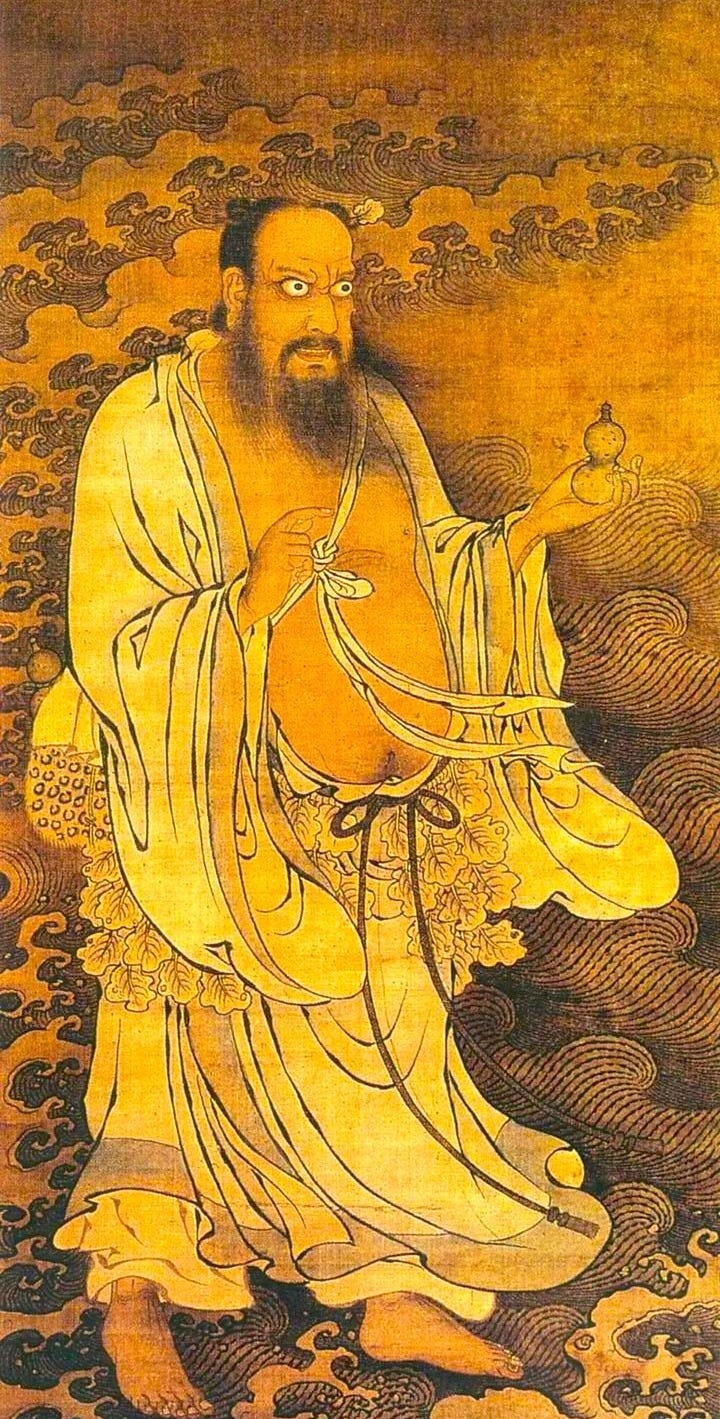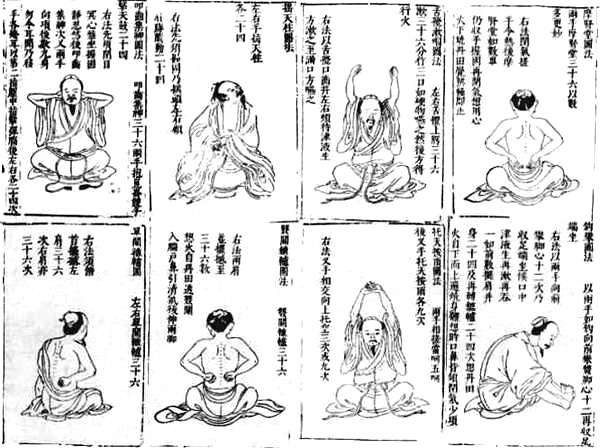Some advanced levels of taijiquan are difficult to reach because highly-focused attention to particular sub-skills is required. Just as the complexities of a movement require ‘breaking down’ actions into component parts, so are there ‘internal skills’ that must mastered independently for later integration into the overall skill. Imagine, for example, a mounted archer who must know both horsemanship and skills with the bow. These skills must be mastered independently and then combined.
Seated baduanjin training allows taijiquan practitioners to master many internal skills in isolation, almost gymnastically, to such a degree that these can later be incorporated into taijiquan practice. If one is go beyond a certain level of skill such types of work are necessary.
What is seated baduanjin?
Eight-section-brocade practices (baduanjin 八段錦) combine stretching, strengthening, coordinated deep-breathing, and self-massage and are most often practiced in standing positions. Baduanjin exercises are undertaken for health, meditation, and martial-arts purposes and fall under the general category of ‘internal training’ (neigong 内功). Neigong, also known as ‘qigong’ (氣功) or ‘vital-energy training,’ is mentioned in Chinese literature as far back as the Song Dynasty (1127-1279).
The sections of brocade placed side-by-side in clothing or fabric art are analogous to the varied ‘sections’ of a neigong exercise routine and, therefore, the discreet skill modules of a practice are referred to as ‘brocades.’
Seated baduanjin is a practice-preparation tool and energy-cultivation method for other neijiaquan arts including internal martial arts. In contrast to standing brocade practices that involve upper and lower body coordination, leg stamina, balancing, etc., seated brocade practice allows for a greater focus on various loci described as ‘brocade centres.’ Practice of the seated baduanjin brings to the practitioner a new energetic vocabulary that, ultimately, forms a substrate for advanced taijiquan study.
Practice of the seated baduanjin brings to the practitioner a new energetic vocabulary that, ultimately, forms a substrate for advanced taijiquan study.
Training the ability of the ‘intention’ (yi 意) to mobilize the ‘vital energy’ (qi 氣) as a basis for action is fundamental to the practice of taijiquan as an energetic art. The eight exercises directly support the ‘decoupling,’ ‘reorienting,’ ‘smelting,’ and ‘repurposing’ of ‘vital energy’ (qi 氣) described in various Daoist ‘alchemical’ (内丹) treatises and also in the Thirteen Powers Song of the ‘Taijiquan Classics.’
Zhongli Quan
The seated method of baduanjin is also known as 'Zhongli Baduanjinfa' (鐘離八段錦法) as its creation is often attributed to Zhongli Quan (鍾離權), a not-successful-military general who later became renowned for his methods of ‘Daoist inner alchemy’ (danjue 丹訣). Also known as ‘Han Zhongli’ (漢鍾離), he is the eighth of the 'Eight Immortals' (Ba Xian 八仙) in Daoist tradition.
Zhongli Quan is, in fact, one of the traditionally credited forefathers of the neidan process further developed by later generations on until the present day. There is an uncanny resemblance between the basic internal-alchemy theory and the brocade sequence and its constituent parts.

The seated baduanjin form
The seated baduanjin form is one of the oldest still-practiced Chinese neigong routines to have been described explicitly and pictorially. In the fifth volume of Joseph Needham’s monumental Science and Civilisation in China the subjects of alchemy, early chemistry, and early chemical technology are presented—including ‘physiological alchemy.’ As part of this collection of alchemical facts and practices Needham presents the entire seated baduanjin.
The seated baduanjin form makes its first appearances in the Ming Dynasty (1368-1644) among the works called Marrow of the Red Phoenix (Chifeng sui 赤鳳髓) written by Zhou Lüjing (周履靖) and in an extensive compilation of Tang dynasty (618–907) and Song dynasty (960-1279) inner-alchemy and breath-training practices called ‘Ten Books on the Cultivation of Perfection’ (Xiuzhen Shishu 修真十書) whose authorship is unknown.

The seated baduanjin form is depicted by drawings of a practitioner exercising amongst ‘floating’ textual instructions. Considering the age and the nature of the document the direction is remarkably explicit. For example, the first brocade directs:
Brocade One: Gnash the teeth to gather the ‘spirit’ (shen 神)—thirty-six times. Clasp the head (kunlun 崑崙) with both hands, and beat the celestial drum (tiangu 天鼓)—twenty-four times. (第一段,叩齒集神三十六,兩手抱崑崙,雙手擊天鼓二十四。)
Learning the seated baduanjin
The Zhongli Baduanjin form can be found in multiple sources today and variations abound. In some iterations the sequence is changed with some brocades having completely different instructions and pictures from the ‘original form.’ Seated baduanjin practitioners are usually depicted in a seated cross-legged position and there are some benefits associated with this. However, this position is not possible for many aspirants as it may aggravate joints and distract from the practice itself. It is, therefore, permissible to practice in a chair.
Versions of the original also exist that expand the basic instructions with greater detail. For example, the first brocade, described above, is centred energetically around the ‘hundred gatherings’ point (baihui 百會) at the headtop. Further, the exercise is connected to one of the ‘eight trigrams’ (bagua 八卦), in this case ☰, or ‘cosmos’ (qian 乾) or ‘heaven.’ Both the ‘brocade centre’ and the trigram have implications for advanced taijiquan practice.
It is generally recommended to learn the ins-and-outs of any neigong practices from an experienced teacher as various phenomenon can occur that might puzzle or even have an adverse effect on the learner. Much of my initial in-person learning came from Grandmaster Dr. Yang Jwing-Ming who has taught seated baduanjin for decades and written on the subject. I have also studied this work from other masters as well.
My approach to this practice leans strongly in the direction of its support for taijiquan as an internal-martial and self-cultivation art. Thus far, I have only transmitted my own knowledge of this work to my ‘indoor students’ (tudi 徒弟). Now it is time for me to begin sharing this work with my others.
List of the Seated Eight-brocades (坐式八段锦)
Preparation Instruction
1. ☰ Heavenly Drum
2. ☳ Shake the Heavenly Pillar
3. ☱ Red Dragon Stirs the Sea
4. ☵ Rub the Court of the Kidneys
5. ☲ Single Pass Windlass
6. ☴ Double Pass Windlass
7. ☶ Supporting Heaven
8. ☷ Grasping with Hooks










